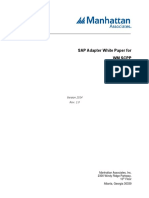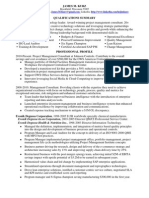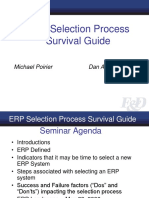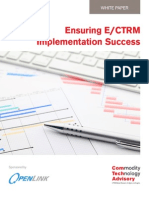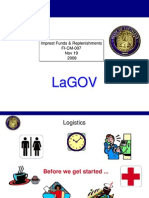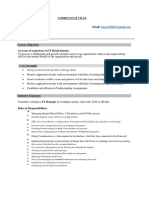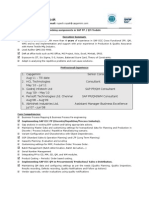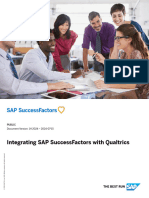Process Mapping in Successful ERP Implementations: Michael D. Okrent and Robert J. Vokurka
Process Mapping in Successful ERP Implementations: Michael D. Okrent and Robert J. Vokurka
Uploaded by
Didik HariadiCopyright:
Available Formats
Process Mapping in Successful ERP Implementations: Michael D. Okrent and Robert J. Vokurka
Process Mapping in Successful ERP Implementations: Michael D. Okrent and Robert J. Vokurka
Uploaded by
Didik HariadiOriginal Description:
Original Title
Copyright
Available Formats
Share this document
Did you find this document useful?
Is this content inappropriate?
Copyright:
Available Formats
Process Mapping in Successful ERP Implementations: Michael D. Okrent and Robert J. Vokurka
Process Mapping in Successful ERP Implementations: Michael D. Okrent and Robert J. Vokurka
Uploaded by
Didik HariadiCopyright:
Available Formats
Introduction
Process mapping in
successful ERP
implementations
Michael D. Okrent and
Robert J. Vokurka
The authors
Michael D. Okrent is based at Southern Connecticut State
University, New Haven, Connecticut, USA.
Robert J. Vokurka is based at Texas A&M University Corpus
Christi, Texas, USA.
Keywords
Process analysis, Process mapping, Business processes,
Resource management
Abstract
This paper discusses the six core business processes and
supporting technology that are impacted by an enterprise
resource planning (ERP) implementation. It begins with a brief
history of the evolution of ERP and the information systems
technology that enabled its development. A discussion of project
implementation team preparations is followed by a description
of process mapping and its significance to the success of an ERP
implementation. Highlights of As-Is and To-Be process
mapping and change management conclude the paper.
The current evolution of operational planning
tools has combined the traditional planning and
control functions with all of the other business
functions to create an overall enterprise planning
system. These enterprise resource planning (ERP)
system implementations typically require several
modules to be implemented and integrated into
the business. There are several different
implementation strategies available to firms.
Many organizations have struggled with these
ERP implementations and have not achieved
the efficiencies and cost savings as originally
planned.
This paper describes the six key business
processes defined by an organization
implementing an ERP system. In consideration of
the implementation options and the common
challenges faced, this organization focused on
process mapping to guide it through its
implementation of its ERP system.
A multinational high technology company being
spun off from a parent company accelerated its
separation from the parent using a Phased Big
Bang ERP implementation approach. The
successful implementation resulted in a reduction
in the total number of information systems
applications from approximately 2,000 to just
three systems in less than two years. Although the
implementation cost was substantial, the firm
received a payback of its ERP investment in less
than 18 months.
Electronic access
The Emerald Research Register for this journal is
available at
www.emeraldinsight.com/researchregister
The current issue and full text archive of this journal is
available at
www.emeraldinsight.com/0263-5577.htm
Industrial Management & Data Systems
Volume 104 Number 8 2004 pp. 637643
q Emerald Group Publishing Limited ISSN 0263-5577
DOI 10.1108/02635570410561618
Enterprise resource planning systems
ERP is the current evolution of a progression of
planning tools that began when computers were
applied to materials planning for production.
The bill of materials processor enabled
communication between previously disparate
groups into a single entity with a common
understanding of the product to be produced.
It brought engineering into the picture as being
responsible for maintaining the parent child
structure, the quantity per unit, and the units of
measure. This information was shared with
production so that they could use a typewriter to
complete requisitions for purchasing to acquire the
materials needed for the product transformation
The companys Project Planning documents are the
source for the definitions and descriptions of the Key
Business Flows described in this paper. The authors
sincere appreciation goes to this companys Project
Team in the thoroughness of its preparation and
ability to respond to unexpected events.
637
Process mapping in successful ERP implementations
Industrial Management & Data Systems
Michael D. Okrent and Robert J. Vokurka
Volume 104 Number 8 2004 637643
process. Accounting and purchasing worked
together via interoffice mail and multiple colored
paper carbon copies to insure that the process
progressed efficiently.
And so it came to pass in the fullness of time that
an organization created the first materials
requirements planning (MRP) system (circa 1965).
This invention allowed the input of planning data
from multiple parts of the organization to be
combined into a consolidated picture of all
production time-phased requirements. It included
a particularly important data element: lead-time.
With the inclusion of lead-time, master planning
could effectively begin to communicate with
marketing to reduce costs, reduce waste, and
improve customer service by enabling the
automation of the available-to-promise function.
Over many years, more and more
manufacturing related systems were added to this
core MRP. So the son of MRP was created,
called MRPII (manufacturing resource planning)
(circa 1980). This innovation combined
accounting activities, such as standard costing, to
be automatically created using the product
structure system. It allowed productions
expediting of critical orders to be linked to the
planning part of the system in order to re-prioritize
the work on the floor. Most importantly for those
very long lead-time items, it allowed the reporting
of reduced lot yields due to scrap or quality failure
while the work was still in progress and reported
this at each work center. This innovation allowed
planners to pull in existing planned orders to avoid
shortages and once again improve customer
service.
And now for the latest evolution of tactical
operational planning systems ERP. ERP takes
the functions of operational planning and control
and combines them with all of the other business
functions to create a synergistic knowledge-based
management environment (Langenwalter, 2000).
What are the advantages of this latest evolution of
this business management tool? Further improved
customer satisfaction, improved profits, reduced
costs, improved quality, improved morale of
employees and faster time to market for new
products (Rao, 2000).
How is all of this possible? Standardization of
business processes and electronically connecting
all the functions in the business into, in effect,
a real-time data warehouse. Each manager and
employee can get the latest information on any
aspect of the product, customer or supplier
relationship. This allows faster information based
decision-making and the improved capability of
reducing costs and improving quality. One of the
newer modules in ERP systems is customer
relationship management (CRM). CRM creates
a window into the customers interactions with the
business. It consolidates the customers
interactions from the inquiry, to purchase, to
after-sales support; from the highest volume
purchasers to the customers who are never
satisfied with the product they purchased. All of this
information is now available to improve
marketing, product development, and production
planning.
ERP technology foundation
ERP does not come without a price. That price
includes, in most cases, an extensive
IT (information technology) infrastructure.
Because most of the transactions are near
real-time, a reliable Intranet or local area network/
wide area network (LAN/WAN) needs to be in
place. The discipline of each person entering data
or status information into the ERP system is
critical. Each piece of data must be entered
immediately upon its availability to maintain
system integrity (Vosburg and Anil, 2001).
In addition to the communications backbone
(LAN/WAN), PC workstations and printers need
to be available to all employees that need to access
or enter information or require hardcopy output
(Langenwalter, 2000). Of course the selection of
an ERP software package and the number and
availability of resources, will ultimately
determine how long and how much it will cost to
implement
ERP projects can take from six months to
several years to complete. During this time the IT
infrastructure and ERP software itself will evolve.
Firms should expect to do a technology roll about
every 24-36 months. What is a technology roll?
According to Moores law, CPU processing power
will either double in performance or its cost will be
cut by one-half approximately every 18 months.
By the time 36 months have passed, the technology
has become so much less expensive for the same or
more performance, that it is cheaper to replace it,
due to maintenance costs, than to retain the old
technology.
ERP software functionality will usually be
available in incremental changes approximately
every six months. What does this mean?
The implementation project teams job, although
diminished after the initial deployment, is really
never finished. As new software releases become
available business processes should be evaluated
to determine if they should be implemented.
People who are knowledgeable about the current
systems and the strategic and tactical direction of
the business are best suited to this task.
638
Process mapping in successful ERP implementations
Industrial Management & Data Systems
Michael D. Okrent and Robert J. Vokurka
Volume 104 Number 8 2004 637643
The six core business processes in ERP
The firm used as a basis of the following discussion
is a high technology, publicly traded company.
It has approximately 30,000 employees around the
world and annual sales in the $5 billion range.
Manufacturing takes place on almost every major
continent and there are over 50 sales offices
worldwide. The company makes a variety of
electronic devices that are used in almost every
industry.
According to the way this organization viewed
their ERP implementation, there are six key
business processes: quote to cash; procure to pay;
plan to perform; manufacturing operations;
product life cycle; and financial management
(Figure 1). The sequence that is described
assumes that there is an ongoing business and the
organization is most effective when planning is
done in a closed loop process that maximizes the
organizations strategic and tactical objectives.
In this firms case the strategic objectives are
defined by the Hoshin planning and monitoring
process.
Quote to cash
Quote-to-Cash includes the steps required to
participate in the marketplace. These steps include
the following:
.
begin with the identification of qualified
customers with needs;
.
apply companys products to address the
needs; and
.
conclude with customer payment for these
goods and services.
There are two major variants to this key business
factor (KBF):
.
Internal Orders, where the Quote is an
Inter-Company Agreement (ICA) and the
Cash is a financial transfer between
organizations; or
Vendor Managed Inventory (VMI), where the
Quote is an agreement to automatically
supply products or components to a customer
under certain pre-defined conditions and
Cash is the automated billing associated
with those deliveries.
Procure to pay
Procure to Pay includes functions associated with
procurement of, and payment for, all materials
required by the Order Fulfillment process.
There is one major variant to this KBF: supplier
managed inventory (SMI) where the Procure
is a negotiated agreement to automatically supply
the company with specified products or
components under certain conditions and the
Pay is the automated payment associated with
the receipt of those materials.
Plan to perform
Plan to Perform includes the planning processes
associated with demand prediction and associated
resource requirements (facilities, personnel, and
raw materials). Financial support includes
activities required to do the following in all
countries where the company has a presence:
.
supply management with financial status and
performance data; and
.
meet statutory and regulatory requirement of
various governments and investors.
Manufacturing operations
Manufacturing operations begins with the receipt
of customer orders and ends with the products
packaged for delivery to the customer. There are
three major manufacturing processes to
Figure 1 Key business flows
639
Process mapping in successful ERP implementations
Industrial Management & Data Systems
Michael D. Okrent and Robert J. Vokurka
Volume 104 Number 8 2004 637643
accommodate production of different classes of
products: discrete, lot-based, and flow.
Product life cycle
Product life cycle includes management from
conception to obsolescence, including product
revisions and upgrades. The primary repository is
called the product data management system it is
the beginning and end of the data needed for the
supply chain. In this process the part numbers,
product structures, options, warranty period, and
initial suppliers are identified. This information is
used for purchasing, manufacturing, and sales to
do forecasting and budgeting in all areas impacted
by new products. At the end of the product life
cycle product structures and components are
made obsolete.
Financial management
Financial management includes all regulatory
reporting. Sub-processes include: accounts
receivable; accounts payable; general ledger; and
fixed assets. Also activities related to tax reporting,
shareholder relations, intellectual property and
Sarbanes-Oxley compliance reporting are located
in this process flow.
ERP project team preparation
Implementation process
In general there are three basic approaches to
implementation: Pilot, Parallel, and Big Bang.
In the Pilot implementation, a specific functional
area is implemented first. This can be across all
facilities in a multi-plant environment. The idea is
to prioritize the functional areas and implement
them in the order that provides the most benefit
first. This requires a great deal of interface
programming to maintain the data flows between
the legacy system and the new module being
implemented. It is also the lowest risk alternative.
If the pilot implementation technique is the least
risk, it also takes the most time as each module is
rolled out.
A second alternative is a Parallel
implementation. Some ERP suppliers prefer this
method since the issue of data integrity and
migration are, for the most part, avoided (Xu et al.,
2002). Data integrity is the process of evaluation
and cleanup of data prior to migration into the
new system. It is the same old story GIGO
(Garbage In, Garbage Out). However, this method
requires extraordinary effort from employees since
each transaction must be entered into the existing
system and then into the new system. If the
employee is interrupted transactions may be
entered into one system, but not the other causing
all kinds of fun looking for the cause of the
variance in the data. This is a moderate risk
alternative.
The last of the three implementation
approaches is the Big bang! Why is it called this?
Its name is derived from the process taken to
implement the new ERP system. A firm prepares,
tests, trains, does everything possible to get ready,
and then over a weekend or a few days the data
in the old system is migrated to the new one.
On Monday morning everyone in the company
starts using the new system and the old one is
simultaneously turned off. This is the most risky
alternative. There will always be unforeseen and
unexpected events. Several famous companies
have been caught in this trap. Mostly high
technology companies that thought it could not
happen to them, found that it could.
A variation on the Big Bang approach is to
combine it with a phased approach. This entails
a series of mini-bangs that effect a logical
portion of the business. One example uses
a division-by-division approach where each one
uses a Big Bang to migrate to the new ERP system.
A second example might use a functional
approach, however this requires interfacing while
both systems are running their parts of the
company, i.e. finance goes first with the new
system across all divisions at one time, followed by
manufacturing and customer support.
Scope creep
One of the biggest challenges of implementing an
ERP system is the desire for the business to retain
its existing processes and modify the software to
match the business. Considering the complexity of
the software, future updates, and enhancements
that may not be implementable without significant
costs for reprogramming. It is by far faster, less
expensive, and more productive to utilize the ERP
systems standard business process flows. The most
common incidence of scope creep in an ERP
implementation is adaptation to existing processes,
rather than adopting the pre-defined ERP business
processes that come with the software package.
Change management
An often-overlooked aspect of ERP
implementations is the effect that the new system
will have on employees and other stakeholders,
e.g. customers and suppliers. Change
management is the human side of the ERP
implementation. With constant, honest
communication via a variety of media,
stakeholders and employees are kept informed of
the status of the ERP project and what it will mean
to them personally. A variety of assessment tools
640
Process mapping in successful ERP implementations
Industrial Management & Data Systems
Michael D. Okrent and Robert J. Vokurka
Volume 104 Number 8 2004 637643
are available to gauge how well a new ERP system
will be received. If there are pockets within the
organization that show low change capability, then
special programs need to be designed to get these
people through the difficult period of transition
from the old system to the new one.
would include any changes for new customers
(e.g. more detailed credit checking) or new
products being ordered (e.g. may not have enough
in stock). This would be considered a sub-process
of the Quote to Cash process.
Process mapping
Process mapping is similar to flow-charting for
a traditional computer program. However, in the
case of a business process map the participants
in the process are usually identified as well.
This is done using a more hierarchical approach
and a perspective for the model that is not found
in the computer program flow chart. There are
three major phases in process mapping and
consequently business process reengineering:
creating the As-Is model, creating the To-Be
model, and Bridging the Chasm, or in other
words, getting from the here and now to the future
state.
As-Is
The As-Is process model can be developed in a
number of ways. The fastest way to do this is with a
multiple step process. First, gather all the key
participants in the same room (ask them to bring
copies of all the documents and system screens
used in the process). Second, unroll a large sheet of
brown paper around the room. Third, tape all the
documents in the agreed sequence from beginning
to end on the brown paper. Fourth, draw lines to
connect all the documents together and annotate
with cycle time and the specific individuals and
organizations responsible for the completion of
that work task. Repeat for each process that is
performed in the business. This activity should
typically be completed within two to four weeks.
This time limit will force the issue of how deep to
go into the layers of the As-Is process and cause
you to focus on the most important or largest areas
of concern (Ridgman, 1996).
Why do an As-Is model at all? Sometimes
processes have evolved to solve a problem with
a particular customer, employee, or manager.
Understanding why the process is performed in
a particular way will permit the elimination of
non-value added work during the last phase of
process mapping, the process simplification phase.
An example of an As-Is process would be how
a customers order is processed. A typical order
would be somehow communicated to the company
via phone, fax or electronically (e-mail or EDI).
It would then go to credit verification, assuming all
is well; it would then go to the warehouse for
picking and shipment. Variations on this process
To-Be
In creating the To-Be process, the first thing that
must be done is to evaluate what processes are
critical to the business (Zhang, 2002). They must
have a strategic impact and be customer focused to
qualify for the top of the list. An idealized process
with no constraints is created in the first part of the
exercise for each critical process. The next step can
be conducted in three ways. The first alternative is
to modify the idealized process for future or
current constraints, investment funds usually
being the biggest constraint in this area, followed
by human resources capabilities. The second
alternative is to bring in some of the ERP vendors
and have them explain how their system can
accommodate the idealized To-Be process or how
they would solve it using their system. A third
technique, which is also a best practice, says to
simplify first before you automate a process.
Eliminate non-value added steps; those that the
customer is not willing to pay for.
An example of the To-Be process would be
where the customer enters their own order via
a Web site with online credit checking, then
transmitted to the warehouse closest to the
customer for shipment. This eliminates delays and
reduces the companys costs to process the order.
A possible modification to this process might be
for a very large order, where special credit
arrangements need to be made prior to shipment.
Bridging the chasm
Moving from todays As-Is to the future To-Be
process, the first item to address in this phase is
creating a change management program. With
proper communications, the usually radical
transition from the As-Is to the To-Be process can
be somewhat mitigated in the sense that there will
be a productivity dip as everyone takes time to get
used to the new process and some of the initial
kinks are ironed out. Examples abound of
organizations coming to a full stop when their
well-tested ERP implementation caused an
unexpected problem that takes several days or
weeks to resolve. Depending upon the
implementation strategy chosen crossing the
chasm from here to the future can be an enjoyable
experience or an unpleasant disaster for those
involved.
The second item to address in this phase is the
creation of teams to actually implement the new
process. These teams would be responsible for
641
Process mapping in successful ERP implementations
Industrial Management & Data Systems
Michael D. Okrent and Robert J. Vokurka
Volume 104 Number 8 2004 637643
training, software customization, testing, data
quality, and other aspects of using the new process.
less than 18 months. In a period on economic
uncertainty for high technology firms, the ERP
investment made a signification contribution to
cost reduction.
The six processes included by the firm were:
quote to cash; procure to pay; manufacturing
operations; product life cycle; plan to perform and
financial management. These processes can be
adapted to most business environments using
process mapping. The As-Is processes are how the
business is currently being run. The To-Be
Processes are how the business would run under
ideal conditions. The roadmap to move from the
As-Is to the To-Be can be considered bridging
a chasm. During the process of implementation
the need for change management becomes readily
apparent. Change management will allow the
organization to recognize that there are significant
human barriers to overcome and that regular
communications is a potent tool to keep everyone
aligned on what is happening and what will happen
in the future. After the implementation is
completed, a program of continuous improvement
must be implemented to lock in the benefits of the
new processes as employees turnover and as new
techniques or technologies are discovered to
further improve the processes.
Locking in new process savings
One of the most interesting aspects of process
engineering is the dynamics of the organization to
erode the improvements from the new process.
For example, as new employees are hired, they
are not adequately trained or disciplined in why
the process must be followed as designed.
Since they were not involved with the design of
the process they may elect to do the work in a way
that optimizes their particular situation
(work environment) and sub-optimizes the entire
process. The most successful way of retaining the
benefits of process engineering is to support them
with a continuous improvement program that
forces small, but constant improvement, to the
new process. This should continue until the next
process review.
A process engineering review should be
scheduled either every three to five years or when
a significant change in the environment occurs.
Moores law indicates that technology is improving
significantly about every 18 months. In 36 months
that technology improvement has now occurred
two times. The opportunity to take advantage of
technology to revise the process should be
considered at this point or soon thereafter to
determine if the new technology is more
cost-effective or if the process can be substantially
reengineered due to the new technology available.
Second, a significant change in the environment
may be because the product, customers, employee
skills, regulations or other factors may make the
process obsolete or cause it to now be less effective
than when it was last designed.
Conclusion
ERP is the culmination of 40 years of improving
systems to plan, procure, and produce products
more effectively. Because ERP systems are so
comprehensive, suggested business processes are
pre-defined. The company described in this paper
selected five core processes to focus on for a
successful implementation.
The organization studied used a phased Big
Bang approach to accelerate the spin-off from its
parent company. This resulted in several areas of
cost savings. First, it eliminated payments to the
former parent company for maintaining its existing
systems around the world. Secondly, it reduced the
total number of systems applications from
approximately 2,000 to just three in less than
two years. Although the initial implementation
cost was substantial, the firm achieved a payback in
References
Langenwalter, G.A. (2000), Enterprise Resources Planning
and beyond : Integrating your Entire Organization,
St Lucie Press, Boca Raton, FL.
Rao, S.S. (2000), Enterprise resource planning: business needs
and technologies, Industrial Management & Data
Systems, Vol. 100 No. 2, pp. 81-8.
Ridgman, T. (1996), Windows of opportunity: timing and entry
strategies, Industrial Management & Data Systems,
Vol. 96 No. 5, pp. 26-31.
Vosburg, J.K. and Anil, K. (2001), Managing dirty data in
organizations using ERP: lessons from a case study,
Industrial Management & Data Systems, Vol. 101 No. 1,
pp. 21-31.
Xu, H., Nord, J.H., Brown, N. and Daryl Nord, G. (2002),
Data quality issues in implementing an ERP, Industrial
Management & Data Systems, Vol. 102 No. 1, pp. 47-58.
Zhang, Q.C. and Qingyu (2002), Business process
re-engineering for flexibility and innovation in
manufacturing, Industrial Management & Data Systems,
Vol. 102 No. 3, pp. 146-52.
Further reading
Anon. (2001), Making the ERP commitment: What controllers
now say about implementation time and costs,
The Controllers Report, No. 05, pp. 1-3.
Chapman, R.L. and Sloan, T.R. (1999), Large firms versus small
firms do they implement CI the same way?, The TQM
Magazine, Vol. 11 No. 2, p. 105.
642
Process mapping in successful ERP implementations
Industrial Management & Data Systems
Michael D. Okrent and Robert J. Vokurka
Volume 104 Number 8 2004 637643
Jaffe, D.T. and Scott, C.D. (1999), Getting your Organization to
Change, Crisp Publications, Menlo Park, CA.
Kannan, G. and Akhilesh, K.B. (2002), Human capital
knowledge value added: a case study in infotech,
Journal of Intellectual Capital, Vol. 3 No. 2, pp. 167-79.
Kapp, K.M., Latham, W.F. and Ford-Latham, H. (2001), Integrated
Learning for ERP Success: a Learning Requirements
Planning Approach, St Lucie Press, Boca Raton, FL.
Klement, R. and Richardson, G. (1997), Business Process
Mapping Techniques for ISO 9001 and 14001
Certifications, APICS International Conference
Proceedings, pp. 242-8.
Kurt, C. (1999), Strategy and execution of ERP upgrades,
Government Finance Review, Vol. 15 No. 4, pp. 43-8.
McClure, M. (2003), Combining ERP with CRM has meant more
TLC for FWMurphy customers, 1to1 Magazine,
March, p. 1.
Mabert, V.A., Soni, A. and Venkataramanan, M.A. (2003),
Enterprise resource planning: managing the
implementation process, European Journal of
Operational Research, Vol. 146 No. 2, pp. 302-14.
Millar, B. (2002), ERP meets CRM and . . . neither blinks,
1to1 Magazine, February, p. 1.
Moore, G.A. (2002), Crossing the Chasm, HarperBusiness,
New York, NY.
Nah, F.F-H. (2002), Enterprise Resource Planning Solutions and
Management, IRM Press, Hershey.
Orlicky, J. (1975), Material Requirements Planning, McGraw-Hill,
New York, NY.
Plossl, G.W. and Wight, O.W. (1967), Production and Inventory
Control; Principles and Techniques, Prentice-Hall,
Englewood Cliffs, NJ.
Pollard, J. (1999), ERP should pay more attention to customer
business process, SunServer, Vol. 13 No. 10, p. 4.
Ptak, C.A. and Schragenheim, E. (2000), ERP: Tools, Techniques,
and Applications for Integrating the Supply Chain,
St Lucie Press, Boca Raton, FL.
Siriginidi, S.R. (2000), Enterprise resource planning in
reengineering business, Business Process Management
Journal, Vol. 6 No. 5, p. 376.
Ullafson, E. (2003), Lecture, Hamden, CT, April 8.
West, R.N. and Shields, M. (1998), Up and running in nine
months, Management Accounting, Vol. 80 No. 6, p. 20.
Wight, O.W. (1974), Production and Inventory Management in
the Computer Age, CBI Publishing, Boston, MA.
Wood, T. and Caldas, M.P. (2001), Reductionism and complex
thinking during ERP implementations, Business Process
Management Journal, Vol. 7 No. 5, p. 387.
Zwirn, H.A. (1998), Organizational change management: the
forgotten factor, APICS International Conference
Proceedings, No. 1, pp. 394-9.
643
You might also like
- Customer Journey Roadmap DFDocument3 pagesCustomer Journey Roadmap DFDzaky FajratamaNo ratings yet
- Basic Clinical Massage TherapyDocument3 pagesBasic Clinical Massage TherapyDidik HariadiNo ratings yet
- Jabilization 2010Document20 pagesJabilization 2010Star GazerNo ratings yet
- SAP Adapter For WM SCPP Integration White Paper 2014Document10 pagesSAP Adapter For WM SCPP Integration White Paper 2014Alejandro SaavedraNo ratings yet
- Intelligent Enterprise Poster For Automotive - Business Capabilities Required On The Journey To The IE and How SAP Supports TheseDocument1 pageIntelligent Enterprise Poster For Automotive - Business Capabilities Required On The Journey To The IE and How SAP Supports ThesePallab DuttaNo ratings yet
- Information Technology Director Program Project Manager in Milwaukee WI Resume James KurzDocument2 pagesInformation Technology Director Program Project Manager in Milwaukee WI Resume James KurzJamesKurzNo ratings yet
- Sikkim Manipal University: "A Study On The Critical Suceess Factors of Erp Life Cycle Implementation at Gorana Group"Document18 pagesSikkim Manipal University: "A Study On The Critical Suceess Factors of Erp Life Cycle Implementation at Gorana Group"AnjaliNo ratings yet
- Lingaiah ResumeDocument6 pagesLingaiah ResumedarapuNo ratings yet
- White Paper - The ERP Selection Process - 10 StepsDocument11 pagesWhite Paper - The ERP Selection Process - 10 StepsMohammad Danish NasimNo ratings yet
- Scope RDSDocument18 pagesScope RDSsanjeevr811No ratings yet
- Sap BudgetDocument4 pagesSap BudgetRajuSPallapuNo ratings yet
- ERP Selection Process Survival Guide PDFDocument20 pagesERP Selection Process Survival Guide PDFasaNo ratings yet
- EPM Key Design Decisions - Design PhaseDocument7 pagesEPM Key Design Decisions - Design PhaseVishwanath GNo ratings yet
- Demantra Demand Management Configure To Order ImplementationDocument8 pagesDemantra Demand Management Configure To Order ImplementationHatakesh PotnuruNo ratings yet
- Enterprise Resource Planning (ERP) : Presented By: Makansingh ChauhanDocument28 pagesEnterprise Resource Planning (ERP) : Presented By: Makansingh ChauhanGuru Darshan0% (1)
- Top 20 ErpDocument96 pagesTop 20 ErpAdnan AbuShahad100% (1)
- ERP SAP Implementation-1214825612078403-9Document22 pagesERP SAP Implementation-1214825612078403-9Uday Bhaskar GurralaNo ratings yet
- Bank Directors ScorecardDocument25 pagesBank Directors ScorecardKeith WardenNo ratings yet
- S/4HANA Cloud Due-Diligence Framework: SAP Best PracticesDocument3 pagesS/4HANA Cloud Due-Diligence Framework: SAP Best PracticesSSNo ratings yet
- JK Tyre & Industries (A4)Document2 pagesJK Tyre & Industries (A4)Dinesh HegdeNo ratings yet
- SAP ByD Solution OverviewDocument25 pagesSAP ByD Solution OverviewRahul SinhaNo ratings yet
- Intelligent Business ProcessDocument4 pagesIntelligent Business Processginper2005No ratings yet
- Ensuring E/CTRM Implementation SuccessDocument10 pagesEnsuring E/CTRM Implementation SuccessCTRM CenterNo ratings yet
- SAP FICO Training Document - 15.07.2017Document152 pagesSAP FICO Training Document - 15.07.2017Vishnu Vikraman0% (1)
- The EPPM Solution Success GuideDocument74 pagesThe EPPM Solution Success GuideCelil ÇİYNEKLİNo ratings yet
- Sap NalcoDocument49 pagesSap NalcoSunita MishraNo ratings yet
- Rolls Royce ExtractDocument12 pagesRolls Royce ExtractGareth Tooley-BowenNo ratings yet
- Oracle Fusion Governance, Risk, and ComplianceDocument2 pagesOracle Fusion Governance, Risk, and Compliancemarinas80No ratings yet
- Peoplesoft Financials ImplementationDocument11 pagesPeoplesoft Financials ImplementationKesava Sumanth ANo ratings yet
- JD SR Sap MM Consultant PDFDocument2 pagesJD SR Sap MM Consultant PDFSrinivas Ds100% (1)
- SAP Retention Process - SAP BlogsDocument25 pagesSAP Retention Process - SAP Blogssekhar dattaNo ratings yet
- Agresso Glossary of TermsDocument7 pagesAgresso Glossary of TermsErick MuliNo ratings yet
- Manage Your Solution OverviewDocument21 pagesManage Your Solution OverviewArchana AshokNo ratings yet
- A Baseline Document Is Defined As Any Official Document That Has Gone Through An Initial Approval Process and Was Approved For Use As IntendedDocument5 pagesA Baseline Document Is Defined As Any Official Document That Has Gone Through An Initial Approval Process and Was Approved For Use As Intendedprasanthp100% (2)
- Software Application and Products in Data ProcessingDocument17 pagesSoftware Application and Products in Data ProcessingCruisecodersNo ratings yet
- SAP Project: Superuser Information Pack (Central Admin)Document19 pagesSAP Project: Superuser Information Pack (Central Admin)Hidayat AliNo ratings yet
- Roll Out InformationDocument2 pagesRoll Out InformationMynameis KhanNo ratings yet
- SIG230 Process-Intelligence SiGNAL-exercisesDocument3 pagesSIG230 Process-Intelligence SiGNAL-exercisesطه السماويNo ratings yet
- Discussion 2.1 - Discussion Clarification and QA.Document2 pagesDiscussion 2.1 - Discussion Clarification and QA.Rosemarie CruzNo ratings yet
- SAP's Guiding Principles For Artificial IntelligenceDocument12 pagesSAP's Guiding Principles For Artificial IntelligenceIoan Alexandru FierascuNo ratings yet
- SAP Activate With Agile Really Works-20dec2020Document8 pagesSAP Activate With Agile Really Works-20dec2020DhanumjayNo ratings yet
- WW Tipsheet-Industry Tips and Tricks From Sap ConcurDocument43 pagesWW Tipsheet-Industry Tips and Tricks From Sap ConcurAntonNo ratings yet
- Planning For A Successful ERP Implementation: An Epicor White PaperDocument10 pagesPlanning For A Successful ERP Implementation: An Epicor White Paperapi-240076591No ratings yet
- SAP Architecture and Technology ManagementDocument6 pagesSAP Architecture and Technology Managementapi-121330393No ratings yet
- Incident ManagementDocument9 pagesIncident ManagementAnurag ThapliyalNo ratings yet
- Project Manager SAP 01Document6 pagesProject Manager SAP 01فروز قاسمNo ratings yet
- Inventory Management: Inventory Management Must Be Designed To Meet The Dictates of MarketDocument17 pagesInventory Management: Inventory Management Must Be Designed To Meet The Dictates of MarketHumaira FathimaNo ratings yet
- Imprest Funds & ReplenishmentsDocument38 pagesImprest Funds & ReplenishmentsraghavNo ratings yet
- Sap Is Retail Sample Resume 2Document4 pagesSap Is Retail Sample Resume 2Deepak Singh PatelNo ratings yet
- ERP Research Ebook SAP S4 Hana 1Document9 pagesERP Research Ebook SAP S4 Hana 1Srijani ChaudhuryNo ratings yet
- Implementation PresentationDocument25 pagesImplementation PresentationSri Kanth100% (2)
- ERP Implementation Issues in PTCLDocument163 pagesERP Implementation Issues in PTCLSyeda Khaula NafeesNo ratings yet
- Crystalbridge - The Data Transformation Platform HarmonizeDocument5 pagesCrystalbridge - The Data Transformation Platform HarmonizeNityaNo ratings yet
- CV RupeshDocument4 pagesCV RupeshRupesh RupakNo ratings yet
- SF HXM Qualtrics IntegrationDocument128 pagesSF HXM Qualtrics Integrationchalalegesse36No ratings yet
- ERP ALL Full FormsDocument5 pagesERP ALL Full FormsRajdipsinh N JadejaNo ratings yet
- Intercompany Integration Solution For SAP Business One: Overview PresentationDocument50 pagesIntercompany Integration Solution For SAP Business One: Overview PresentationCuong Nguyen TanNo ratings yet
- Public Cloud ERP for Small or Midsize Businesses A Complete Guide - 2019 EditionFrom EverandPublic Cloud ERP for Small or Midsize Businesses A Complete Guide - 2019 EditionNo ratings yet
- Beginning Java Ee 6 HolDocument29 pagesBeginning Java Ee 6 HolDidik HariadiNo ratings yet
- Manufacturing WorkflowDocument1 pageManufacturing WorkflowDidik HariadiNo ratings yet
- An R Programming Quick Reference: Basic Data RepresentationDocument13 pagesAn R Programming Quick Reference: Basic Data RepresentationDidik HariadiNo ratings yet
- Odoo Functional Training v8 Pos PDFDocument9 pagesOdoo Functional Training v8 Pos PDFDidik HariadiNo ratings yet
- Calico PDFDocument6 pagesCalico PDFDidik HariadiNo ratings yet
- Infor SunSystems For Oil and Gas BrochureDocument4 pagesInfor SunSystems For Oil and Gas BrochureDidik HariadiNo ratings yet
- Pelvic Exercises For MenDocument3 pagesPelvic Exercises For MenDidik HariadiNo ratings yet
- Hammer PDFDocument12 pagesHammer PDFDidik HariadiNo ratings yet
- Openerp Sales Strategy: How To Sell Openerp !Document31 pagesOpenerp Sales Strategy: How To Sell Openerp !Didik HariadiNo ratings yet
- Infor FMS SunSystemsDocument4 pagesInfor FMS SunSystemsDidik Hariadi100% (1)
- Itb PDFDocument12 pagesItb PDFDidik HariadiNo ratings yet
- TENS Machine Instructions PDFDocument1 pageTENS Machine Instructions PDFDidik HariadiNo ratings yet




